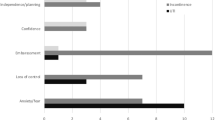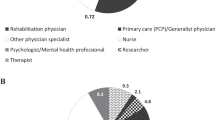Abstract
Study design
Qualitative descriptive.
Objectives
To describe the experiences of people with Spinal Cord Injury (SCI) re-admitted to the hospital due to continence-related complications.
Setting
Inpatient service of a large spinal unit in North-West of Italy.
Methods
Semi-structured interviews were conducted on a purposive sample of people with SCI (n = 11; age range 22–66 years, n = 5 females, n = 6 with cervical injuries), audio-recorded, and transcribed verbatim (duration range 38–52 min). Data were analysed inductively using the thematic analysis approach as described by Braun and Clarke.
Results
Three main themes were identified: (i) managing the frustration of continence-related complications; (ii) finding your way to deal with continence-related complications; (iii) identifying precise needs to deal with continence-related complications. Obtained findings highlighted the perceived emotional and physical burden suffered by people with SCI and their caregivers regarding the constant look for solutions and renounces to social participation, the different strategies implemented to address continence-related complications, and the unmet or partially met needs of people with SCI regarding support in transition to the community, infrastructure, and reliable information or education.
Conclusions
Continence-related complications have a significant impact on the lives of people with SCI and their families. Interventions using technological tools and peer participation could reduce the burden associated with continence-related complications. Specific instruments are needed to facilitate evaluation, goal setting, and promote discussion of continence to allow HCPs to support people with SCI. Structured follow-up for SCI survivors should also focus on their needs to improve knowledge, facilitate decision making, and promote preventive behaviours.
This is a preview of subscription content, access via your institution
Access options
Subscribe to this journal
Receive 12 print issues and online access
$259.00 per year
only $21.58 per issue
Buy this article
- Purchase on Springer Link
- Instant access to full article PDF
Prices may be subject to local taxes which are calculated during checkout
Similar content being viewed by others
Data availability
The transcriptions of interviews generated and analysed during the current study are available from the corresponding author on reasonable request.
References
Ehrmann C, Reinhardt JD, Joseph C, Hasnan N, Perrouin-Verbe B, Tederko P, et al. Describing functioning in people living with spinal cord injury across 22 countries: a graphical modeling approach. Arch Phys Med Rehabil. 2020;101:2112–43.
Simpson LA, Eng JJ, Hsieh JTC, Wolfe DL. Spinal Cord Injury Rehabilitation Evidence Scire Research Team The health and life priorities of individuals with spinal cord injury: a systematic review. J Neurotrauma. 2012;29:1548–55.
Tang DH, Colayco DC, Khalaf KM, Piercy J, Patel V, Globe D, et al. Impact of urinary incontinence on healthcare resource utilization, health-related quality of life and productivity in patients with overactive bladder. BJU Int. 2014;113:484–91.
Nielsen SD, Faaborg PM, Finnerup NB, Christensen P, Krogh K. Ageing with neurogenic bowel dysfunction. Spinal Cord. 2017;55:769–73.
Kaplan SA, Dmochowski R, Cash BD, Kopp ZS, Berriman SJ, Khullar V. Systematic review of the relationship between bladder and bowel function: implications for patient management. Int J Clin Pract. 2013;67:205–16.
Brinkhof MWG, Al-Khodairy A, Eriks-Hoogland I, Fekete C, Hinrichs T, Hund-Georgiadis M, et al. Health conditions in people with spinal cord injury: contemporary evidence from a population-based community survey in Switzerland. J Rehabil Med. 2016;48:197–209.
Ginsberg D. The epidemiology and pathophysiology of neurogenic bladder. Am J Manag Care. 2013;19:s191–6.
Awad RA. Neurogenic bowel dysfunction in patients with spinal cord injury, myelomeningocele, multiple sclerosis and Parkinson’s disease. World J Gastroenterol. 2011;17:5035–48.
Gabbe BJ, Nunn A. Profile and costs of secondary conditions resulting in emergency department presentations and readmission to hospital following traumatic spinal cord injury. Injury. 2016;47:1847–55.
Wu SY, Jhang JF, Liu HH, Chen JT, Li JR, Chiu B, et al. Long-term surveillance and management of urological complications in chronic spinal cord-injured patients. J Clin Med. 2022;11:7307.
Taweel WA, Seyam R. Neurogenic bladder in spinal cord injury patients. Res Rep Urol. 2015;7:85–99.
Coggrave M, Norton C, Cody JD. Management of faecal incontinence and constipation in adults with central neurological diseases. Cochrane Database Syst Rev. 2014;2014:CD002115. https://www.cochranelibrary.com/cdsr/doi/10.1002/14651858.CD002115.pub5/abstract.
Consortium for Spinal Cord Medicine. Bladder management for adults with spinal cord injury: a clinical practice guideline for health-care providers. J Spinal Cord Med. 2006;29:527–73.
Kurze I, Geng V, Böthig R. Guideline for the management of neurogenic bowel dysfunction in spinal cord injury/disease. Spinal Cord. 2022;60:435–43.
Liu CW, Attar KH, Gall A, Shah J, Craggs M. The relationship between bladder management and health-related quality of life in patients with spinal cord injury in the UK. Spinal Cord. 2010;48:319–24.
Pardee C, Bricker D, Rundquist J, MacRae C, Tebben C. Characteristics of neurogenic bowel in spinal cord injury and perceived quality of life. Rehabil Nurs J Assoc Rehabil Nurses. 2012;37:128–35.
Welk B, Morrow S, Madarasz W, Baverstock R, Macnab J, Sequeira K. The validity and reliability of the neurogenic bladder symptom score. J Urol. 2014;192:452–7.
Krogh K, Christensen P, Sabroe S, Laurberg S. Neurogenic bowel dysfunction score. Spinal Cord. 2006;44:625–31.
Wilde MH, Brasch J, Zhang Y. A qualitative descriptive study of self-management issues in people with long-term intermittent urinary catheters. J Adv Nurs. 2011;67:1254–63.
Braaf S, Lennox A, Nunn A, Gabbe B. Social activity and relationship changes experienced by people with bowel and bladder dysfunction following spinal cord injury. Spinal Cord. 2017;55:679–86.
Nevedal A, Kratz AL, Tate DG. Women’s experiences of living with neurogenic bladder and bowel after spinal cord injury: life controlled by bladder and bowel. Disabil Rehabil. 2016;38:573–81.
Engkasan JP, Ng CJ, Low WY. Factors influencing bladder management in male patients with spinal cord injury: a qualitative study. Spinal Cord. 2014;52:157–62.
Todd C, Woodward S. Experience of nurses caring for patients with neurogenic bowel dysfunction: a qualitative study. J Wound Ostomy Continence Nurs. 2018;45:163–7.
Sandelowski M. What’s in a name? Qualitative description revisited. Res Nurs Health. 2010;33:77–84.
Braun V, Clarke V. Using thematic analysis in psychology. Qual Res Psychol. 2006;3:77–101.
Conti A, Clari M, Kangasniemi M, Martin B, Borraccino A, Campagna S. What self-care behaviours are essential for people with spinal cord injury? A systematic review and meta-synthesis. Disabil Rehabil. 2020;44:991–1006.
Allin S, Shepherd J, Thorson T, Tomasone J, Munce S, Linassi G, et al. Web-based health coaching for spinal cord injury: results from a mixed methods feasibility evaluation. JMIR Rehabil Assist Technol. 2020;7:e16351.
Drake MJ, Cortina-Borja M, Savic G, Charlifue SW, Gardner BP. Prospective evaluation of urological effects of aging in chronic spinal cord injury by method of bladder management. Neurourol Urodyn. 2005;24:111–6.
Chen SF, Jiang YH, Jhang JF, Lee CL, Kuo HC. Bladder management and urological complications in patients with chronic spinal cord injuries in Taiwan. Tzu Chi Med J. 2014;26:25–8.
Boucher ML, Gelling L, Tait D. The emerging patient-led revolution of early colostomy following spinal cord injury. J Clin Nurs. 2023;32:e22–3. https://onlinelibrary.wiley.com/doi/abs/10.1111/jocn.16616.
Hagen EM, Rekand T. Management of bladder dysfunction and satisfaction of life after spinal cord injury in Norway. J Spinal Cord Med. 2014;37:310–6.
Hoffman JM, Bombardier CH, Graves DE, Kalpakjian CZ, Krause JS. A longitudinal study of depression from 1 to 5 years after spinal cord injury. Arch Phys Med Rehabil. 2011;92:411–8.
Conti A, Dimonte V, Rizzi A, Clari M, Mozzone S, Garrino L, et al. Barriers and facilitators of education provided during rehabilitation of people with spinal cord injuries: a qualitative description. PLOS ONE. 2020;15:e0240600.
Krassioukov A, Eng JJ, Claxton G, Sakakibara BM, Shum S. Neurogenic bowel management after spinal cord injury: a systematic review of the evidence. Spinal Cord. 2010;48:718–33.
Pavese C, Schneider MP, Schubert M, Curt A, Scivoletto G, Finazzi-Agrò E, et al. Prediction of bladder outcomes after traumatic spinal cord injury: a longitudinal cohort study. PLOS Med. 2016;13:e1002041.
O’Brien BC, Harris IB, Beckman TJ, Reed DA, Cook DA. Standards for reporting qualitative research: a synthesis of recommendations. Acad Med. 2014;89:1245–51.
Acknowledgements
We wish to thank the participants and the staff at the Spinal Cord Injury Unit of Città della Salute e della Scienza Hospital of Torino for dedicating their time to this study.
Author information
Authors and Affiliations
Contributions
AC, MT, and RS were responsible for designing and writing the study protocol, and for submitting the study to ethical approval. AC and EP were also responsible for writing the report. MT conducted all the interviews and transcribed them verbatim. AC, ML and EC were responsible for data analysis. RS and SC provided feedback on the report.
Corresponding author
Ethics declarations
Competing interests
The authors declare no competing interests.
Ethical approval
The study design was approved by the Città della Salute e della Scienza Hospital of Turin Ethics Committee (Resolution n˚ 105785/2016—#CS2/28). All participants were orally contacted by the researchers (MT, AC), received written information, and signed their informed consent to the interviews. All applicable institutional and governmental regulations concerning the ethical use of human volunteers were followed during this research. Anonymity was guaranteed during data transcription and presentation by providing participants with a number code.
Additional information
Publisher’s note Springer Nature remains neutral with regard to jurisdictional claims in published maps and institutional affiliations.
Rights and permissions
Springer Nature or its licensor (e.g. a society or other partner) holds exclusive rights to this article under a publishing agreement with the author(s) or other rightsholder(s); author self-archiving of the accepted manuscript version of this article is solely governed by the terms of such publishing agreement and applicable law.
About this article
Cite this article
Conti, A., Pradovera, E., Luciani, M. et al. Experiences of people with spinal cord injuries readmitted for continence-related complications: a qualitative descriptive study. Spinal Cord 62, 26–33 (2024). https://doi.org/10.1038/s41393-023-00943-w
Received:
Revised:
Accepted:
Published:
Issue Date:
DOI: https://doi.org/10.1038/s41393-023-00943-w



